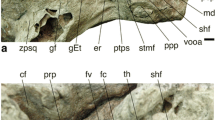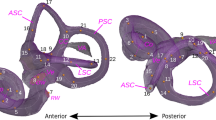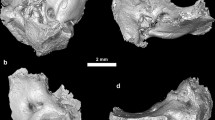Abstract
The ear region of the pen-tailed treeshrew, Ptilocercus lowii Gray, 1848 (Scandentia, Ptilocercidae), is described and illustrated in detail based on five museum specimens from the National Museum of Natural History, two with the auditory bulla removed exposing the intratympanic surfaces. Soft tissues (arteries, veins, nerves, and muscles) are reconstructed onto the adult skulls based on published reports of these elements in a fetal P. lowii. Comparisons are made with four specimens of the common treeshrew, the tupaiid Tupaia glis (Diard, 1820), from the Carnegie Museum of Natural History, including one with the auditory bulla removed.
The mammalian ear region widely is regarded to be a rich source of characters for phylogenetic analysis. This study supports this view by identifying numerous features that are shared between the two treeshrews as well as numerous features that distinguish them. Several features used in the past to distinguish tupaiid treeshrews from primates are found to differ between P. lowii and T. glis: the composition of the bony tubes for the internal carotid artery and the composition of the intrabullar septa and spaces. Despite the compositional differences, it seems likely that the bony carotid tubes and intrabullar septa and spaces shared by P. lowii and T. glis occurred in their common ancestor. Evaluating the utility of these and other ear region features awaits future phylogenetic analysis of treeshrews and related Euarchontoglires.














Similar content being viewed by others
References
Bloch JI, Silcox MT (2006) Cranial anatomy of the Paleocene plesiadapiform Carpolestes simpsoni (Mammalia, Primates) using ultra high-resolution X-ray computed tomography, and the relationships of plesiadapiforms to Euprimates. J Hum Evol 50:1–35
Bloch JI, Silcox MT, Boyer DM, Sargis EJ (2007) New Paleocene skeletons and the relationship of plesiadapiforms to crown-clade primates. PNAS 104:1159–1164
Cartmill M, MacPhee RDE (1980) Tupaiid affinities: the evidence of the carotid arteries and cranial skeleton. In: Luckett WP (ed) Comparative Biology and Evolutionary Relationships of Tree Shrews. Plenum, New York, pp 95–132
Diamond M (1989) Coarctation of the stapedial artery: an unusual adaptive response to competing functional demands in the middle ear of some eutherians. J Morph 200:71–86
Doran AHG (1878) Morphology of mammalian ossicula auditûs. Trans Linn Soc Lond Zool 2nd Ser 1:391–497
Evans HE (1993) Miller’s Anatomy of the Dog. WB Saunders, Philadelphia
Fleischer G (1973) Studien am Skelett des Gehörorgans der Säugetiere, einschließlich des Menschen. Saugetierkundl Mitteil 21:131–239
Gaudin TJ (1995) The ear region of edentates and the phylogeny of the Tardigrada (Mammalia, Xenarthra). J Vertebr Paleontol 15:672–705
Giannini NP, Wible JR, Simmons NB (2006) On the cranial osteology of Chiroptera. I. Pteropus (Megachiroptera: Pteropodidae). Bull Am Mus Nat Hist 295:1–134
Gregory WK (1910) The orders of mammals. Bull Am Mus Nat Hist 27:1–524
Helgen KM (2005) Order Scandentia. In: Wilson DE, Reeder DM (eds) Mammals of the World: A Taxonomic and Geographic Reference, 3rd edn. Johns Hopkins University Press, Baltimore, pp 104–109
Henson OW Jr (1961) Some morphological and functional aspects of certain structures of the middle ear in bats and insectivores. Univ Kansas Sci Bull 52(3):151–255
Hinchcliffe R, Pye A (1969) Variations in the middle ear of the Mammalia. J Zool London 157:277–288
Hunt RM Jr, Korth WW (1980) The auditory region of Dermoptera: morphology and function relative to other living mammals. J Morph 164:167–211
Kampen PN van (1905) Die Tympanalgegend des Säugetierschädels. Morph Jb 34:321–722
Kay RF, Thewissen JGM, Yoder AD (1992) Cranial anatomy of Ignacius graybullianus and the affinities of the Plesiadapiformes. Am J Phys Anthropol 89:477–498
Klaauw CJ van der (1922) Uber die Entwickelung des Entotympanicums. Tijdschr Ned Dierk Vereen 18:135–174
Klaauw CJ van der (1931) The auditory bulla in some fossil mammals with a general introduction to this region of the skull. Bull Am Mus Nat Hist 42:1–352
Le Gros Clark WE (1925) On the skull of Tupaia. Proc Zool Soc Lond 1925:559–567
Le Gros Clark WE (1926) On the anatomy of the pen-tailed tree shrew (Ptilocercus lowii). Proc Zool Soc Lond 1926:1179–1309
Le Gros Clark WE (1959) The Antecedents of Man, an Introduction to the Evolution of the Primates, 1st edn. Edinburgh University Press, Edinburgh
Lyon MW Jr (1913) Treeshrews: an account of the mammalian family Tupaiidae. Proc US Natl Mus 45:1–188
MacIntyre GT (1972) The trisulcate petrosal pattern of mammals. In: T Dobzhansky, MK Hecht, WC Steere (eds) Evol Biol 6:275–303
MacPhee RDE (1979) Entotympanics, ontogeny and primates. Folia Primatol 31:23–47
MacPhee RDE (1981) Auditory regions of primates and eutherian insectivores: morphology, ontogeny, and character analysis. Contrib Primatol 18:1–282
McDowell SB Jr (1958) The Greater Antillean insectivores. Bull Am Mus Nat Hist 115:113–214
McKenna MC, Bell SK (1997) Classification of Mammals above the Species Level. Columbia University Press, New York
Murphy WJ, Eizirik E, O’Brien SJ, Madsen O, Scally M, Douady CJ, Teeling E, Ryder OA, Stanhope MJ, de Jong WW, Springer MS (2001) Resolution of the early placental radiation using Bayesian phylogenetics. Science 294:2348–2351
Novacek MJ (1980) Cranioskeletal features in tupaiids and selected Eutheria as phylogenetic evidence. In: Luckett WP (ed) Comparative Biology and Evolutionary Relationships of Tree Shrews. Plenum, New York, pp 35–93
Olson LE, Sargis EJ, Martin RD (2004) Phylogenetic relationships among treeshrews (Scandentia): a review and critique of the morphological evidence. J Mammal Evol 11:49–71
Olson LE, Sargis EJ, Martin RD (2005) Intraordinal phylogenetics of treeshrews (Mammalia: Scandentia) based on evidence from the mitochondrial 12S rRNA gene. Mol Phylogen Evol 35:656–673
Rougier GW, Wible JR, Hopson JA (1992) Reconstruction of the cranial vessels in the Early Cretaceous mammal Vincelestes neuquenianus: implications for the evolution of the mammalian cranial vascular system. J Vertebr Paleontol 12:188–216
Saban R (1956/1957) Les affinités du genre Tupaia Raffles 1821 d’après les caractères morphologiques de la tête osseuse. Ann Paléontol 42:169–224, 43:1–43
Saban R (1963) Contribution à l’étude de l’os temporal des Primates. Description chez l’Homme et les Prosimiens. Anatomie comparée et phylogénie. Mém Mus Natl Hist Nat Sér A Zool 29:1–378
Sargis EJ (2001) A preliminary qualitative analysis of the axial skeleton of tupaiids (Mammalia, Scandentia): functional morphology and phylogenetic implications. J Zool London 253:473–483
Sargis EJ (2002a) Functional morphology of the forelimb of tupaiids (Mammalia, Scandentia) and its phylogenetic implications. J Morphol 254:10–42
Sargis EJ (2002b) Functional morphology of the hindlimb of tupaiids (Mammalia, Scandentia) and its phylogenetic implications. J Morphol 254:149–185
Sargis EJ (2002c) The postcranial morphology of Ptilocercus lowii (Scandentia, Tupaiidae): an analysis of primatomorphan and volitantian characters. J Mammal Evol 9:137–160
Sargis EJ (2004) New views on tree shrews: the role of tupaiids in primate supraordinal relationships. Evol Anthropol 13:56–66
Sargis EJ (2007) The postcranial morphology of Ptilocercus lowii (Scandentia, Tupaiidae) and its implications for primate supraordinal relationships. In: Ravosa MJ, Dagosto M (eds) Primate Origins: Adaptations and Evolution. Springer, New York, pp 51–82
Shoshani J, McKenna MC (1998) Higher taxonomic relationships among extant mammals based on morphology, with selected comparisons of results from molecular data. Mol Phylogen Evol 9(3):572–584
Spatz WB (1964) Beitrag zur Kenntnis der Ontogenese des Cranium von Tupaia glis (Diard 1820). Morph Jb 106:321–416
Spatz WB (1966) Zur Ontogenese der Bulla tympanica von Tupaia glis Diard 1820 (Prosimiae, Tupaiiformes). Folia Primatol 4:26–50
Springer MS, Murphy WJ, Eizirik E, O’Brien SJ (2005) Molecular evidence for major placental clades. In: Rose KD, Archibald JD (eds) The Rise of Placental Mammals: Origins and Relationships of the Major Extant Clades. The Johns Hopkins University Press, Baltimore, pp 37–49
Szalay FS, Katz C (1973) Phylogeny of lemurs, galagos and lorises. Folia Primatol 19:88–103
Van Valen L (1965) Tree shrews, primates and fossils. Evolution 19:137–151
Voit M (1909) Das Primordialcranium des Kaninchens unter Berücksichtigung der Deckknochen. Ein Beitrag zur Morphologie des Säugetierschädels. Anat Hefte 38:425–616
Wible JR (1987) The eutherian stapedial artery: character analysis and implications for superordinal relationships. Zool J Linn Soc 91:107–135
Wible JR (1990) Late Cretaceous marsupial petrosal bones from North America and a cladistic analysis of the petrosal in therian mammals. J Vertebr Paleontol 10:183–205
Wible JR (2003) On the cranial osteology of the short-tailed opossum Monodelphis brevicaudata (Didelphidae, Marsupialia). Ann Carnegie Mus 72(3):137–202
Wible JR (2007) On the cranial osteology of the Lagomorpha. In: Beard KC, Luo Z-X (eds) Mammalian Paleontology on a Global Stage: Papers in Honor of Mary R. Dawson. Bull Carnegie Mus Nat Hist 39:213–234
Wible JR (2008) On the cranial osteology of the Hispaniolan solenodon, Solenodon paradoxus Brandt, 1833 (Mammalia, Lipotyphla, Solenodontidae). Ann Carnegie Mus 77(3):321–402
Wible JR, Gaudin TJ (2004) On the cranial osteology of the yellow armadillo Euphractus sexcinctus (Dasypodidae, Xenarthra, Placentalia). Ann Carnegie Mus 73(3):117–196
Wible JR, Novacek MJ, Rougier GW (2004) New data on the skull and dentition of the Mongolian Cretaceous eutherian mammal Zalambdalestes. Bull Am Mus Nat Hist 281:1–144
Wible JR, Rougier GW (2000) Cranial anatomy of Kryptobaatar dashzevegi (Multituberculata, Mammalia) from the Mongolian Late Cretaceous, and its bearing on the evolution of mammalian characters. Bull Am Mus Nat Hist 247:1–124
Wible JR, Rougier GW, Novacek MJ, Asher RJ (in press) The eutherian mammal Maelestes gobiensis from the Late Cretaceous of Mongolia and the phylogeny of Cretaceous Eutheria. Bull Am Mus Nat Hist
Wible JR, Wang Y-Q, Li C-K, Dawson MR (2005) Cranial anatomy and relationships of a new ctenodactyloid (Mammalia, Rodentia) from the early Eocene of Hubei Province, China. Ann Carnegie Mus 74(2):91–150
Wible JR, Zeller U (1994) Cranial circulation of the pen-tailed tree shrew Ptilocercus lowii and relationships of Scandentia. J Mammal Evol 2:209–230
Wilson DE (1993) Order Scandentia. In: Wilson DE, Reeder DM (eds) Mammal Species of the World: A Taxonomic and Geographic Reference, 2nd edn. Smithsonian Institution, Washington, pp 131–133
Yates TL (1984) Insectivores, elephant shrews, tree shrews, and dermopterans. In: Anderson S, Knox Jones J Jr (eds) Orders and Families of Recent Mammals of the World. Wiley, New York, pp 117–144
Zeller U (1983) Zur Ontogenese und Morphologie des Craniums von Tupaia belangeri (Tupaiidae, Scandentia, Mammalia). Med Diss, Göttingen
Zeller U (1985) Die Ontogenese und Morphologie der Fenestra rotunda und des Aquaeductus cochleae von Tupaia und anderen Säugern. Morph Jb 131:179–204
Zeller U (1986) Ontoegny and cranial morphology of the tympanic region of the Tupaiidae, with special reference to Ptilocercus. Folia Primatol 47:61–80
Zeller U (1987) Morphogenesis of the mammalian skull with special reference to Tupaia. In: Kuhn H-J, Zeller U (eds) Morphogenesis of the Mammalian Skull. Mammalia Depicta 13: 17–50
Acknowledgments
This report was inspired by the exquisite artistry of two extraordinary illustrators. The project initiated years ago with Claire Vanderslice, who made the pencil drawings of USNM 488058 and 311313 in Figs. 1 and 4, and the line drawings of USNM 488058 and 311313 in Figs. 2 and 3a. Paul Bowden of Carnegie Museum of Natural History made amendments to these and completed all the remaining illustrations. For access to specimens, I am extremely grateful to the Division of Mammals of the National Museum of Natural History; without their patience in extending loans to me this project would never have been completed. For observations on several anatomical issues that improved the manuscript, I thank Mary Silcox. Comments by two anonymous reviewers greatly improved the final product. This work was supported by Carnegie Museum of Natural History and National Science Foundation ATOL grant 0629959.
Author information
Authors and Affiliations
Corresponding author
Rights and permissions
About this article
Cite this article
Wible, J.R. The Ear Region of the Pen-tailed Treeshrew, Ptilocercus lowii Gray, 1848 (Placentalia, Scandentia, Ptilocercidae). J Mammal Evol 16, 199–233 (2009). https://doi.org/10.1007/s10914-009-9116-z
Published:
Issue Date:
DOI: https://doi.org/10.1007/s10914-009-9116-z




